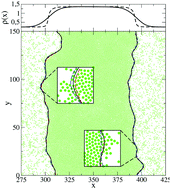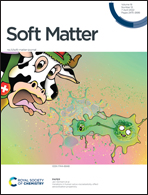Intrinsic structure perspective for MIPS interfaces in two-dimensional systems of active Brownian particles†
Abstract
Suspensions of active Brownian particles (ABPs) undergo motility-induced phase separation (MIPS) over a wide range of mean density and activity strength, which implies the spontaneous aggregation of particles due to the persistence of their direction of motion, even in the absence of an explicit attraction. Both similarities and qualitative differences have been obtained when the MIPS is analysed in the same terms as a liquid–gas phase coexistence in an equilibrium attractive system. Negative values of the mechanical surface tension have been reported, from the total forces across the interface, while stable fluctuations of the interfacial line could be interpreted as a positive capillary surface tension; in equilibrium liquid surfaces, these two magnitudes are equal. We present here the analysis of 2D-ABP interfaces in terms of the intrinsic density and force profiles, calculated with the particle distance to the instantaneous interfacial line. Our results provide new insight into the origin of MIPS from the local rectification of the random active force on the particles near the interface. As has been reported, this effect acts as an external potential that produces a pressure gradient across the interface, such that the mechanical surface tension of the MIPS cannot be described as that of equilibrium coexisting phases; however, our analysis shows that most of that effect comes from the tightly caged particles at the dense (inner) side of the MIPS interface, rather than from the free moving particles at the outer side that collide with the dense cluster. Moreover, a clear correlation appears between the decay of the hexatic order parameter at the dense slab and the end of the MIPS as the strength of the active force is lowered. We show that, using the strong active forces required for MIPS, the interfacial structure and properties are very similar for ABPs with purely repulsive interactions (the Weeks–Chandler–Andersen–Lennard-Jones (WCA-LJ) model truncated at its minimum) and when the interaction includes a range of the LJ attractive force.



 Please wait while we load your content...
Please wait while we load your content...